Abstract
"Functional antagonism" is often used to describe the general relaxant effect of beta 2 agonists and xanthines and their ability to protect the airways against bronchoconstrictor stimuli. This study in guinea pig isolated trachea addresses the question of whether the capacity of these drugs to protect against constrictor stimuli is related to smooth muscle relaxation. Three antimuscarinic drugs were also examined to determine whether antagonism of mediators other than muscarinic agonists might contribute to bronchodilatation by these antimuscarinic drugs. Terbutaline (1.1 x 10(-7), 2.2 x 10(-7) M), theophylline (2.2 x 10(-4), 4.4 x 10(-4) M), and enprofylline (5.2 x 10(-5), 1.0 x 10(-4) M) relaxed the tracheal tension that remained after indomethacin treatment. They did not, however, alter the carbachol concentration-response curve significantly. In addition, neither theophylline (2.2 x 10(-4) M) nor terbutaline (1.1 x 10(-7) M) altered histamine induced contraction. Atropine sulphate, glycopyrrolate, and ipratropium bromide had EC50 values of 10(-9) - 10(-8) M for relaxation of carbachol induced contractions, whereas concentrations of 10(-6) - 10(-3) M or greater were required to relax contractions induced by allergen and nine other non-muscarinic mediators. It is suggested that bronchodilatation by antimuscarinic drugs in vivo is due to inhibition of acetylcholine induced bronchoconstriction alone and that beta 2 agonists and xanthines have poor ability to protect airway smooth muscle against constrictor stimuli. Hence mechanisms other than bronchodilatation and "functional antagonism" should be considered to explain the protection against constrictor stimuli in asthma seen with beta 2 agonists and xanthines.
Full text
PDF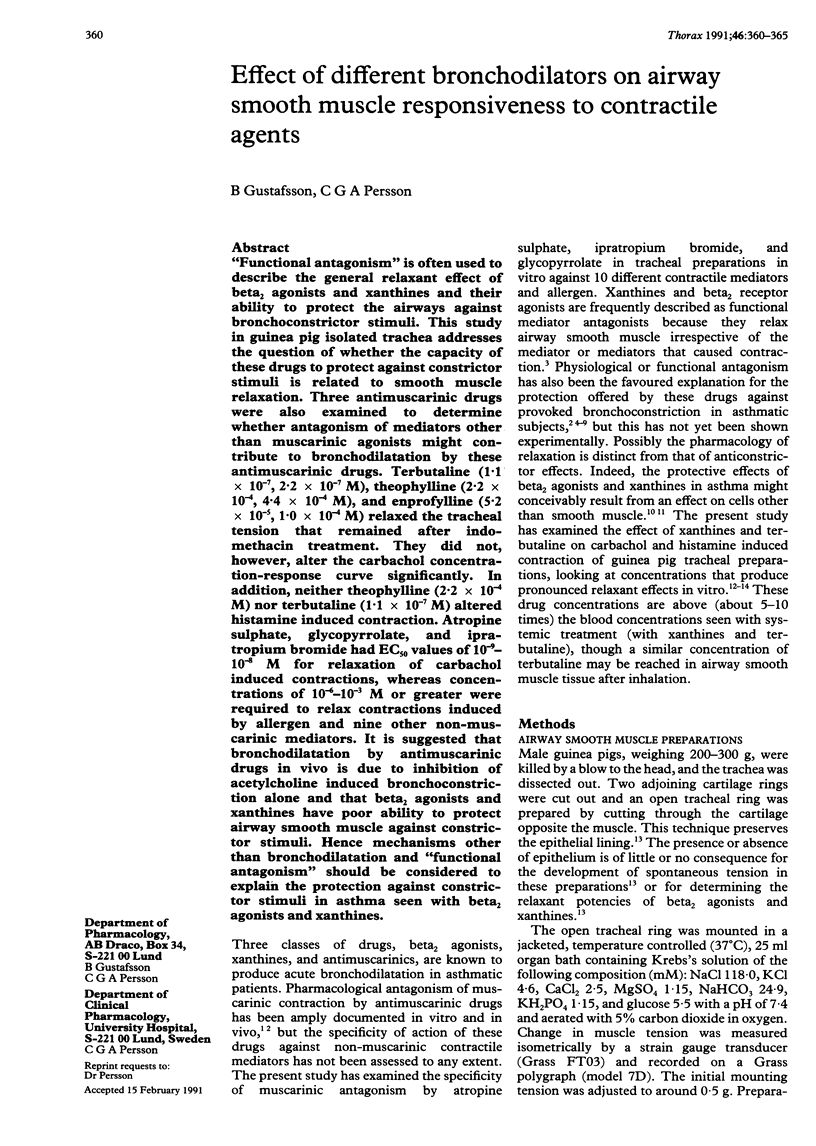
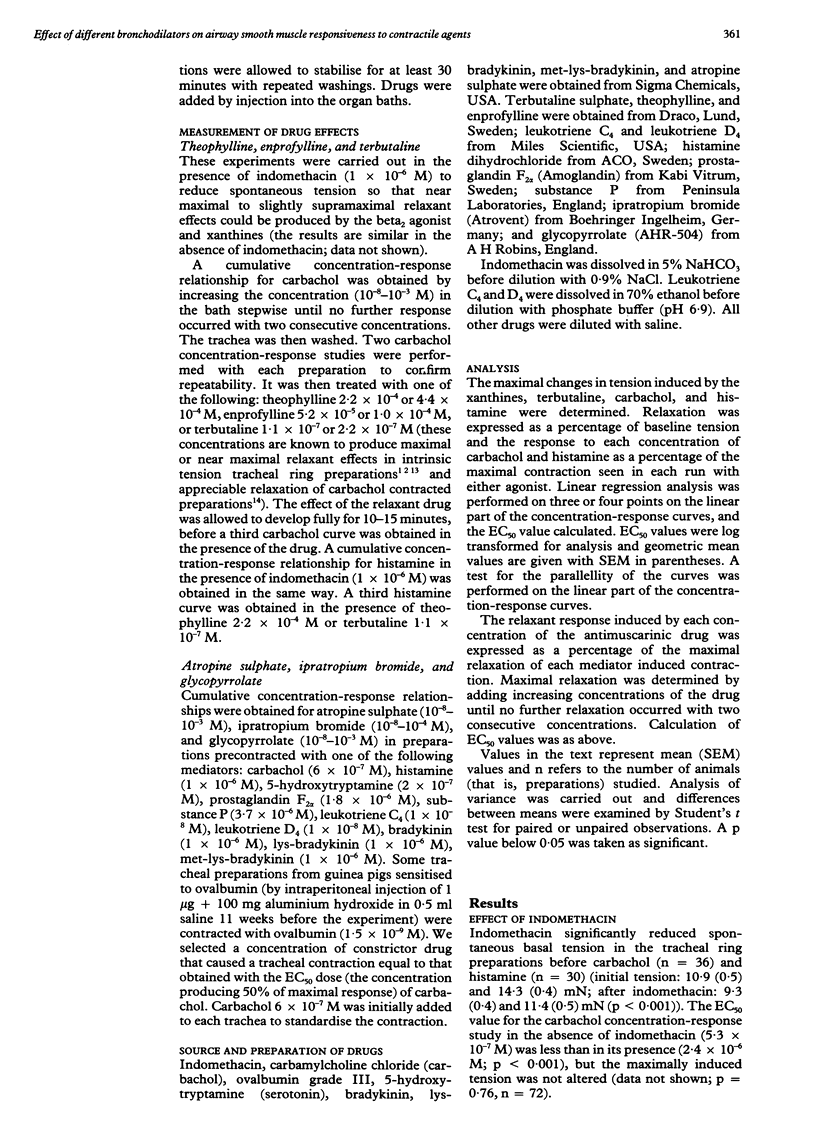
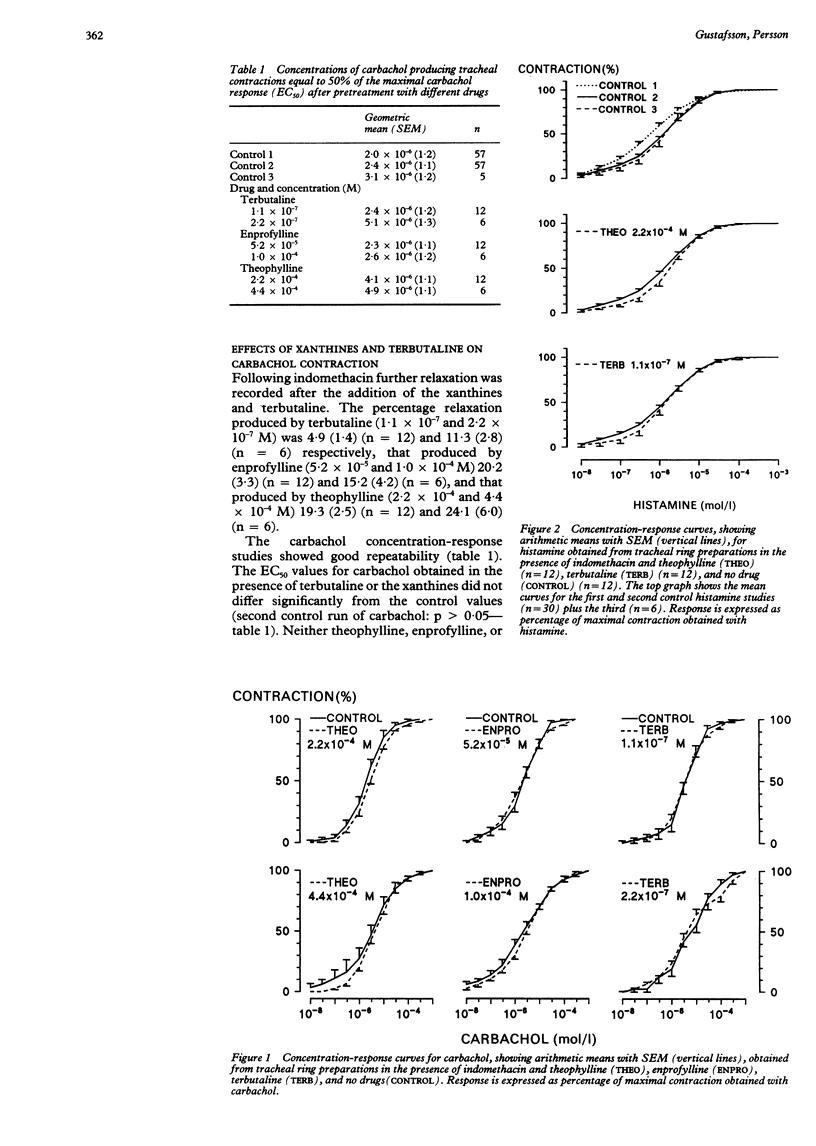
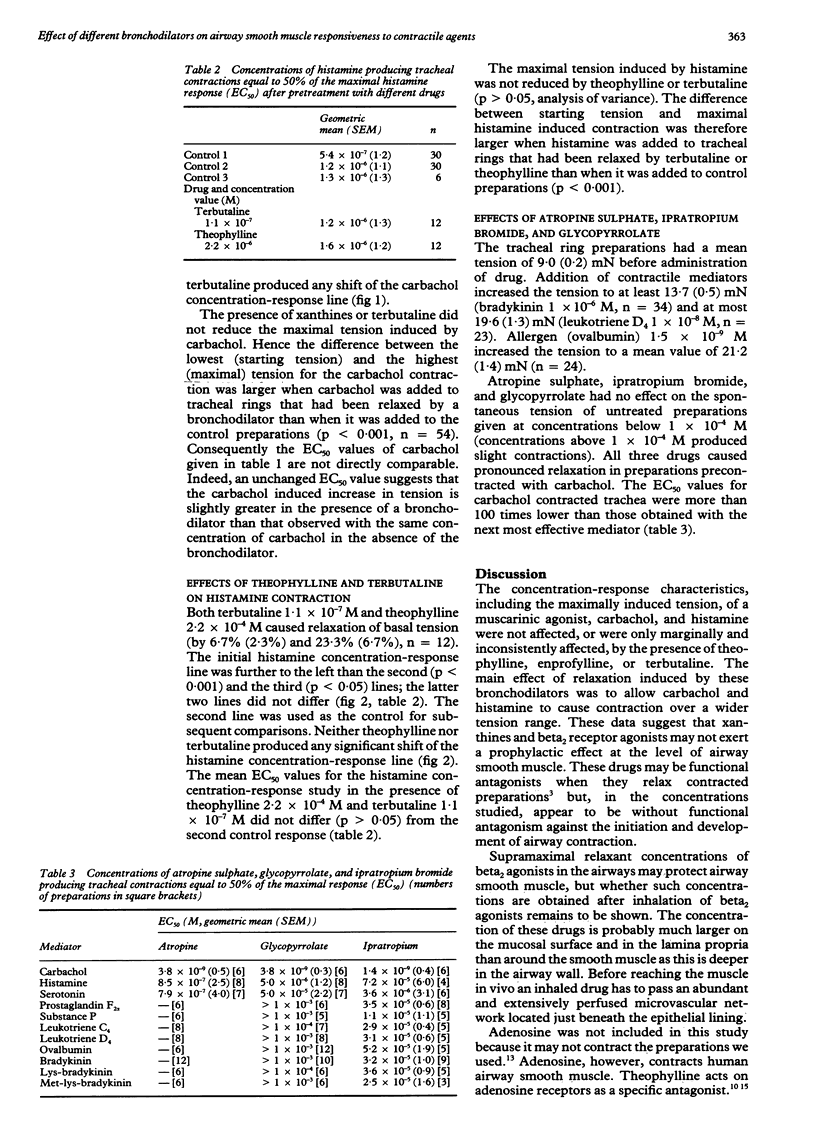
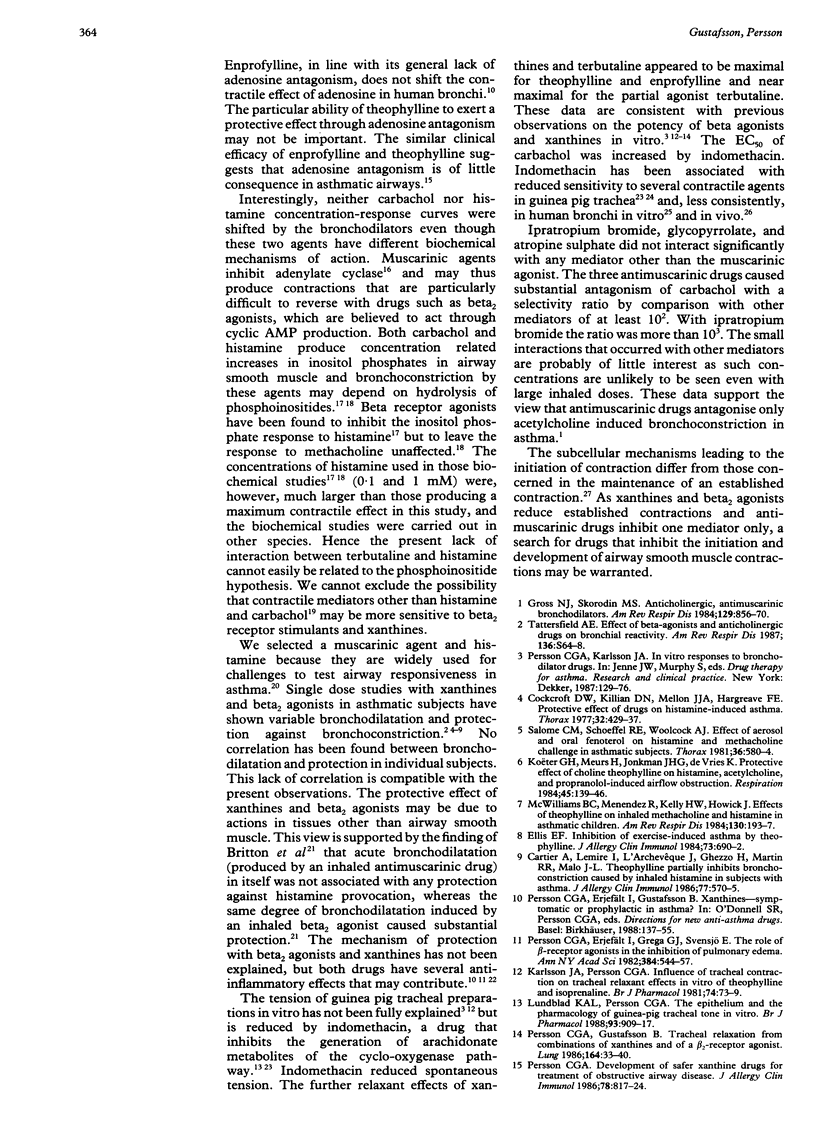
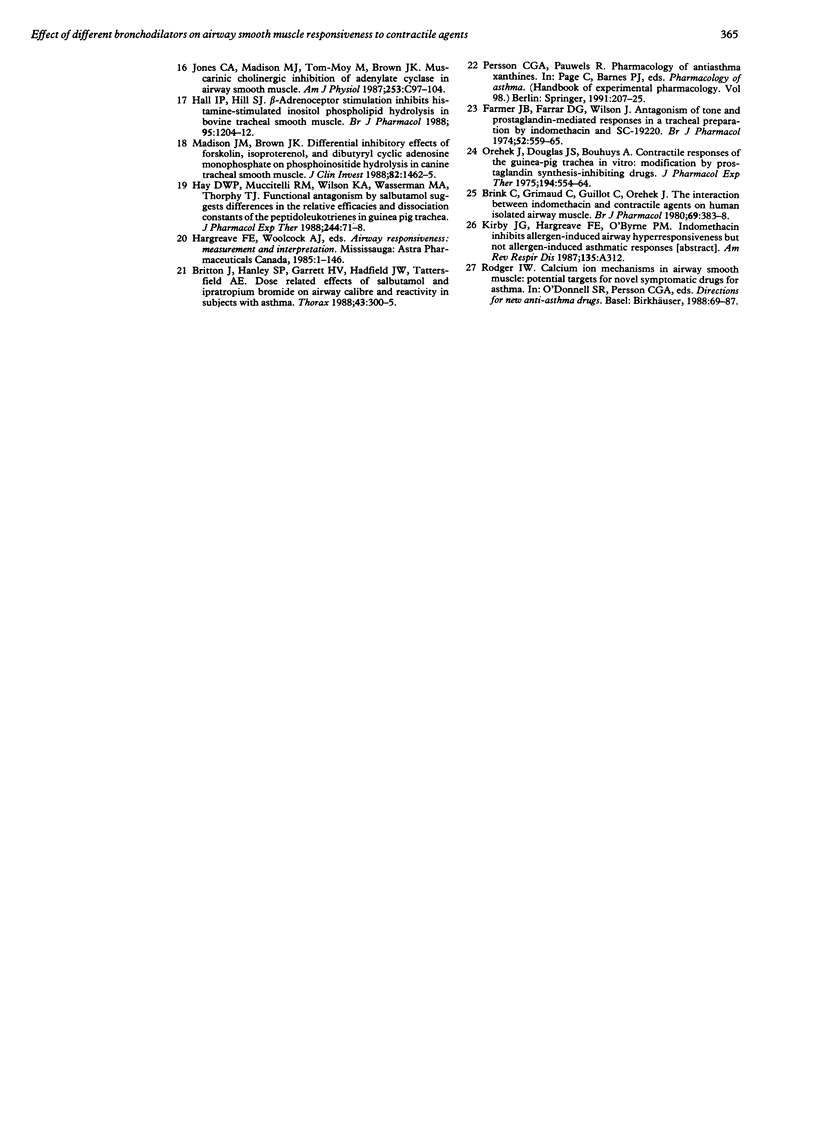
Selected References
These references are in PubMed. This may not be the complete list of references from this article.
- Brink C., Grimaud C., Guillot C., Orehek J. The interaction between indomethacin and contractile agents on human isolated airway muscle. Br J Pharmacol. 1980 Jul;69(3):383–388. doi: 10.1111/j.1476-5381.1980.tb07026.x. [DOI] [PMC free article] [PubMed] [Google Scholar]
- Britton J., Hanley S. P., Garrett H. V., Hadfield J. W., Tattersfield A. E. Dose related effects of salbutamol and ipratropium bromide on airway calibre and reactivity in subjects with asthma. Thorax. 1988 Apr;43(4):300–305. doi: 10.1136/thx.43.4.300. [DOI] [PMC free article] [PubMed] [Google Scholar]
- Cartier A., Lemire I., L'Archevêque J., Ghezzo H., Martin R. R., Malo J. L. Theophylline partially inhibits bronchoconstriction caused by inhaled histamine in subjects with asthma. J Allergy Clin Immunol. 1986 Apr;77(4):570–575. doi: 10.1016/0091-6749(86)90347-7. [DOI] [PubMed] [Google Scholar]
- Cockcroft D. W., Killian D. N., Mellon J. J., Hargreave F. E. Protective effect of drugs on histamine-induced asthma. Thorax. 1977 Aug;32(4):429–437. doi: 10.1136/thx.32.4.429. [DOI] [PMC free article] [PubMed] [Google Scholar]
- Ellis E. F. Inhibition of exercise-induced asthma by theophylline. J Allergy Clin Immunol. 1984 May;73(5 Pt 2):690–692. doi: 10.1016/0091-6749(84)90307-5. [DOI] [PubMed] [Google Scholar]
- Farmer J. B., Farrar D. G., Wilson J. Antagonism of tone and prostaglandin-mediated responses in a tracheal preparation by indomethacin and SC-19220. Br J Pharmacol. 1974 Dec;52(4):559–565. doi: 10.1111/j.1476-5381.1974.tb09724.x. [DOI] [PMC free article] [PubMed] [Google Scholar]
- Gross N. J., Skorodin M. S. Anticholinergic, antimuscarinic bronchodilators. Am Rev Respir Dis. 1984 May;129(5):856–870. doi: 10.1164/arrd.1984.129.5.856. [DOI] [PubMed] [Google Scholar]
- Hall I. P., Hill S. J. Beta-adrenoceptor stimulation inhibits histamine-stimulated inositol phospholipid hydrolysis in bovine tracheal smooth muscle. Br J Pharmacol. 1988 Dec;95(4):1204–1212. doi: 10.1111/j.1476-5381.1988.tb11757.x. [DOI] [PMC free article] [PubMed] [Google Scholar]
- Hay D. W., Muccitelli R. M., Wilson K. A., Wasserman M. A., Torphy T. J. Functional antagonism by salbutamol suggests differences in the relative efficacies and dissociation constants of the peptidoleukotrienes in guinea pig trachea. J Pharmacol Exp Ther. 1988 Jan;244(1):71–78. [PubMed] [Google Scholar]
- Jones C. A., Madison J. M., Tom-Moy M., Brown J. K. Muscarinic cholinergic inhibition of adenylate cyclase in airway smooth muscle. Am J Physiol. 1987 Jul;253(1 Pt 1):C97–104. doi: 10.1152/ajpcell.1987.253.1.C97. [DOI] [PubMed] [Google Scholar]
- Karlsson J. A., Persson C. G. Influence of tracheal contraction on relaxant effects in vitro of theophylline and isoprenaline. Br J Pharmacol. 1981 Sep;74(1):73–79. doi: 10.1111/j.1476-5381.1981.tb09956.x. [DOI] [PMC free article] [PubMed] [Google Scholar]
- Koëter G. H., Meurs H., Jonkman J. H., de Vries K. Protective effect of choline theophyllinate on histamine, acetylcholine, and propranolol-induced airflow obstruction. Respiration. 1984;45(2):139–146. doi: 10.1159/000194610. [DOI] [PubMed] [Google Scholar]
- Lundblad K. A., Persson C. G. The epithelium and the pharmacology of guinea-pig tracheal tone in vitro. Br J Pharmacol. 1988 Apr;93(4):909–917. doi: 10.1111/j.1476-5381.1988.tb11479.x. [DOI] [PMC free article] [PubMed] [Google Scholar]
- Madison J. M., Brown J. K. Differential inhibitory effects of forskolin, isoproterenol, and dibutyryl cyclic adenosine monophosphate on phosphoinositide hydrolysis in canine tracheal smooth muscle. J Clin Invest. 1988 Oct;82(4):1462–1465. doi: 10.1172/JCI113752. [DOI] [PMC free article] [PubMed] [Google Scholar]
- McWilliams B. C., Menendez R., Kelly H. W., Howick J. Effects of theophylline on inhaled methacholine and histamine in asthmatic children. Am Rev Respir Dis. 1984 Aug;130(2):193–197. doi: 10.1164/arrd.1984.130.2.193. [DOI] [PubMed] [Google Scholar]
- Orehek J., Douglas J. S., Bouhuys A. Contractile responses of the guinea-pig trachea in vitro: modification by prostaglandin synthesis-inhibiting drugs. J Pharmacol Exp Ther. 1975 Sep;194(3):554–564. [PubMed] [Google Scholar]
- Persson C. G. Development of safer xanthine drugs for treatment of obstructive airways disease. J Allergy Clin Immunol. 1986 Oct;78(4 Pt 2):817–824. doi: 10.1016/0091-6749(86)90067-9. [DOI] [PubMed] [Google Scholar]
- Persson C. G., Erjefält I., Grega G. J., Svensjö E. The role of beta-receptor agonists in the inhibition of pulmonary edema. Ann N Y Acad Sci. 1982;384:544–557. doi: 10.1111/j.1749-6632.1982.tb21399.x. [DOI] [PubMed] [Google Scholar]
- Persson C. G., Erjefält I., Gustafsson B. Xanthines--symptomatic or prophylactic in asthma? Agents Actions Suppl. 1988;23:137–155. doi: 10.1007/978-3-0348-9156-1_10. [DOI] [PubMed] [Google Scholar]
- Persson C. G., Gustafsson B. Tracheal relaxation from combinations of xanthines and of a beta 2-receptor agonist and xanthines. Lung. 1986;164(1):33–40. doi: 10.1007/BF02713627. [DOI] [PubMed] [Google Scholar]
- Rodger I. W. Calcium ion mechanisms in airway smooth muscle: potential targets for novel symptomatic drugs for asthma. Agents Actions Suppl. 1988;23:69–87. doi: 10.1007/978-3-0348-9156-1_4. [DOI] [PubMed] [Google Scholar]
- Salome C. M., Schoeffel R. E., Woolcock A. J. Effect of aerosol and oral fenoterol on histamine and methacholine challenge in asthmatic subjects. Thorax. 1981 Aug;36(8):580–584. doi: 10.1136/thx.36.8.580. [DOI] [PMC free article] [PubMed] [Google Scholar]
- Tattersfield A. E. Effect of beta-agonists and anticholinergic drugs on bronchial reactivity. Am Rev Respir Dis. 1987 Oct;136(4 Pt 2):S64–S68. doi: 10.1164/ajrccm/136.4_Pt_2.S64. [DOI] [PubMed] [Google Scholar]


